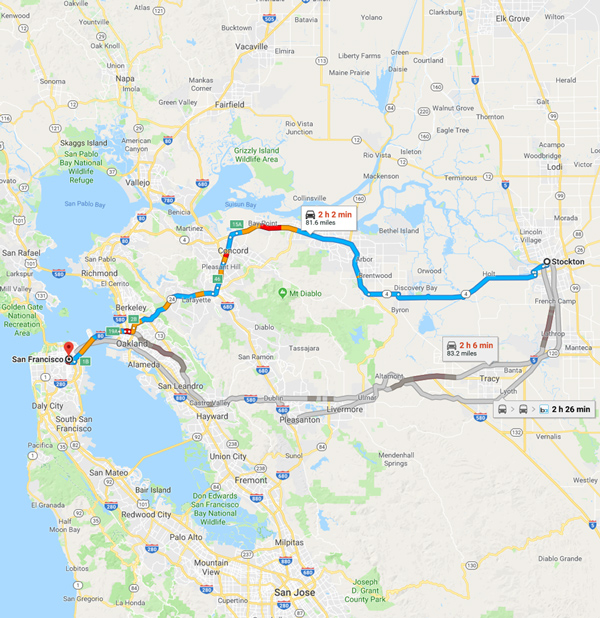Originally Posted: Summer 2018
Shifts in the dynamics of cities have impacted housing markets, causing prices for high-demand neighborhoods to skyrocket and leaving long commutes for those who can’t afford the prices. How can we avoid housing becoming a limiting factor in economic mobility?
 Stockton, California, to San Francisco is a 81.6 mile drive — and not an uncommon commute. (Google Maps)
Stockton, California, to San Francisco is a 81.6 mile drive — and not an uncommon commute. (Google Maps)Last year the New York Times ran a story on Ms. Sheila James, a 62-year-old woman who commutes two hours and 50 minutes each way between her home in Stockton, California, and her $81,000-a-year government job in San Francisco.
The number of Americans like Ms. James with extreme commutes is growing, but their stories represent unusual exceptions that illustrate a larger pattern. More and more Americans are moving to less expensive regions of the country, or, more commonly, settling for the limited opportunities available in struggling communities like Stockton. These changes in the economic geography of American cities have far-reaching implications for upward mobility and economic growth.
More and more Americans are moving to less expensive regions of the country, or, more commonly, settling for the limited opportunities available in struggling communities like Stockton. These changes in the economic geography of American cities have far-reaching implications for upward mobility and economic growth.
Underlying the dilemmas many Americans face about where to live and work are two long-term reversals in the economy. First, for much of the 20th century, Americans were more willing to move in pursuit of economic betterment than people in any other advanced country, and the dominant flow of people was from poorer to wealthier locations. The best known migratory patterns were from farms and small towns to regional cities, from Southern agriculture to Northern manufacturing, and from poorer heartland areas to booming cities on the West Coast.
This pattern has now reversed. Mobility across state lines has fallen almost by half since the 1980s. In addition, virtually all the highest-income metro areas have experienced net domestic population outflows. READ MORE